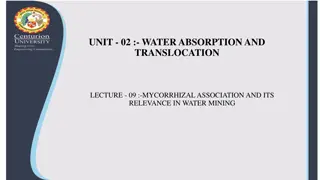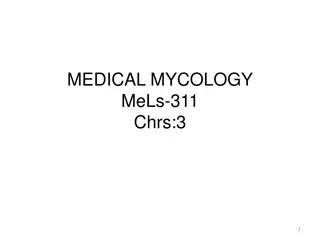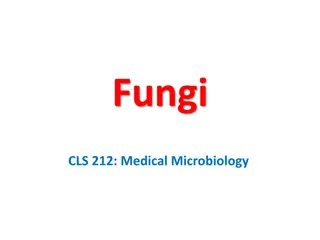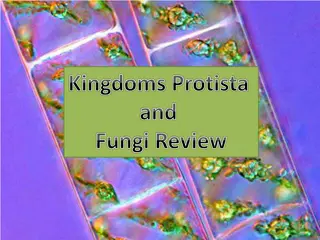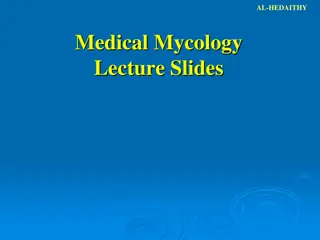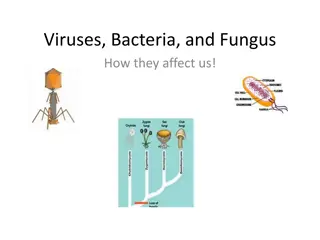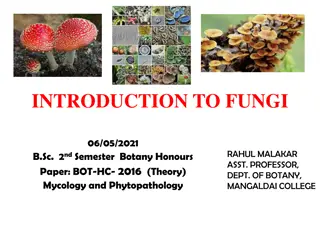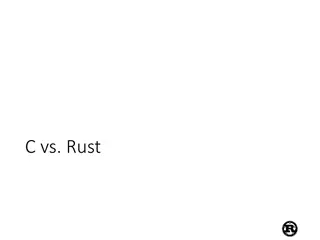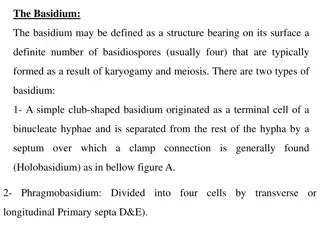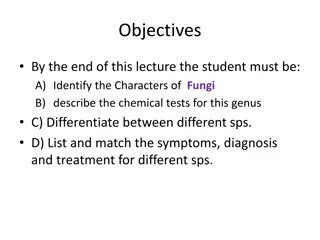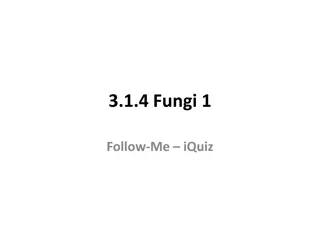Understanding Rust and Smut Fungi in Basidiomycotina
Basidiomycotina is a diverse group of fungi encompassing classes like Teliomycetes and Hymenomycetes. Rust and smut fungi belong to the class Teliomycetes, characterized by dikaryotic resting spores and unique modes of reproduction. Within the Teliomycetes, the order Uredinales, known as rust fungi, are notorious for causing devastating losses to crops like wheat. These fungi exhibit complex life cycles involving multiple hosts and spore types. Studying these fungi is crucial for effective disease management strategies.
Download Presentation

Please find below an Image/Link to download the presentation.
The content on the website is provided AS IS for your information and personal use only. It may not be sold, licensed, or shared on other websites without obtaining consent from the author. Download presentation by click this link. If you encounter any issues during the download, it is possible that the publisher has removed the file from their server.
E N D
Presentation Transcript
Rust and Smut Dr. Sobia Ilyas Assistant Professor Department of Botany Lahore College for Women University
General Characteristics of Basidiomycotina Mycelium is septate. Dolipore septum is present except rusts and smuts. Clamp connections present. Cell wall consists of chitin and glucans. Sexual spores are basidiospores. They are exogenously produced on basidium.
Classes of Basidiomycotina Teliomycetes Hymenomycetes Basidiocarp lacking and replaced by Teliospores grouped in sori or scattered within the host tissues Basidiocarp usually well- developed, Basidia typically organized as a hymenium; Saprobes or rarely parasites
Class: Teliomycetes ( Rust and Smut) Mycelial hyphae septate and the septa are of simple type. Asexual reproduction is uncommon, through dikaryotic spores of conidial nature produced in rusts while in smut fungi, haploid sporidia may bud off into daughter cells. Basidiocarps absent. The class is characterized by thick walled, dikaryotic resting spores commonly called as teliospores in rusts and chlamydospores in smuts, Karyogamy takes place in this part and therefore, is actually a probasidium. The resting spores on germination produce promycelium (metabasidium) into which diploid nucleus moves and after meiosis four haploid nuclei are produced. These nuclei later, result in the formation of haploid basidiospores.
Division of Teliomycetes The class is divided into 2 orders: Ustilaginales Uredinales Basidia aseptate or septate, number of basidiospores indefinite Basidia becoming septate, bearing 2 to 4 basidiospores, one at each septum and one nearly terminal.
Order Uredinales (The rust fungi) Commonly called as 'rust fungi' due to the characteristic reddish brown colour of some of their spores. First described by Theophrastus on grains in Historia plantarum. These are obligate parasites and cause great losses to many cultivated crops. Has two hosts: Wheat and alternate hosts Barberry. Urediospores and teliospores occur on Wheat while Spermatogonium and aeciospores occur on Barberry. The mycelium is septate without clamp connections. It grows intercellularly, frequently producing haustoria. In general, these fungi cause local infections in above ground parts of plants but sometimes these are systemic and may overwinter in roots or other parts.In recent years, rusts have been grown in tissues and axenic cultures e.g., Puccinia malvacearum, M. lini.
Rust of linseed (flax):- host-linum usitatissimum and pathogen-melampsora lini.
Important terms in Life cycle of Uredinales The rust in which life cycle is short and completed by only two types of spores (teleutospores and basidiospores) called microcyclic rust. The rust which has all the five spore stages (teleutospore, basidiospore, spermatia, pycniospore, aeciospore and uredospore) in its life cycle called macrocyclic rust. A macrocyclic rust in which uredospores are not formed has been named as demicyclic rust. The rust fungi that complete their life cycle in one host are termed as autoecious and those requiring two hosts for the completion of their life cycle are called as heteroecious.
Types of spores during rust cycle The rust fungi produce upto five types of spores in their life cycle, as given below: Stage 0: Spermagonia with spermatia and receptive hyphae . Stage I : Aecia with aeciospores Stage II: Uredia with uredospores Stage III: Telia with teleutospores Stage IV: Basidia with basidiospores
Stage (0) (a) Pycniospores These are the spores produced in a flask-shaped structure called as pycnium, containing a palisade of sporogenous cells which produce spores in nectar exuded from the ostiole. Periphyses and flexuous hyphae (receptive hyphae) are commonly present in pycnia. Pycnia are formed in the host after it is infected by the basidiospores. Pycniospores are single celled and behave as spermatia.
Stage (I) (b) Aeciospores These are single celled dikaryotic spores produced in chains in cup-like structures known as aecia. The spores are yellow to orange in colour with a hyaline characteristically verrucose wall.
Stage (II) (c) Uredospores These are single celled binucleate, pedicellate deciduous spores borne in naked or paraphysate sori breaking through the host epidermis, commonly called as uredia or uredinia. Uredospores are brown, echinulate having almost conspicuous germ pores. They behave as conidia and repeat several cycles in a season and are also called as summer spores.
Stage(III) (d)Teliospores These are binucleate; pedicellate or sessile; erumpent or embedded in host tissue. They may be single celled, bicelled or more than 2-celled, with dark brown walls, having one or more germ pores. They produce basidium and basidiospores upon germination.
Stage(IV) e) Basidiospores They are haploid, unicellular spores borne on sterigma. These arise from cylindrical to club-shaped 2 to 4 celled basidia.
Order: Ustilaginales( The Smut fungi) Taxonomic classification Kingdom: Fungi Phylum: Basidiomycota Class: Basidiomycetes Order: Ustilaginales Family: Ustilaginaceae Genus: Ustilago
Ustilaginales( The Smut fungi) All smuts are autoecious. The smuts may be intercellular or intracellular (U. maydis). Haustoria are present. Clamp connections are common. It produces only one kind of binucleate spores called the smut pores which are comparable to the teleutospores of rusts. Smut spores are formed from the intercalary cells. The teleutospores are unicellular and binucleate. The single-celled teleutospores, germinates to produce a single epibasidium which bears a variable number of basidiospores. They are not borne on the sterigmata nor are they discharged violently.
Characteristics Smut Rust Perfect spore Intercalary Terminal Number of basidiospores per promycellium Many Definite and four Basidiospores Globular Sickle shaped, elliptical Basidiospores are borne on Short Sterigmata Sessile spores Basidiospores discharge Discharged violently Not discharged violently Teleutospores They are formed from terminal cells of binucleate mycelium They are formed from intercalary cells of binucleate mycelium Basidiocarp Rare Absent Clamp connection Present Rare Parasitism Facultative saprobes Biotrophs Sex organs Absent Specialized Heteroceism Absent Common Polymorphism Absent Distinct Parasitic mycelium Intercellular with haustoria Intercellular with haustoria


